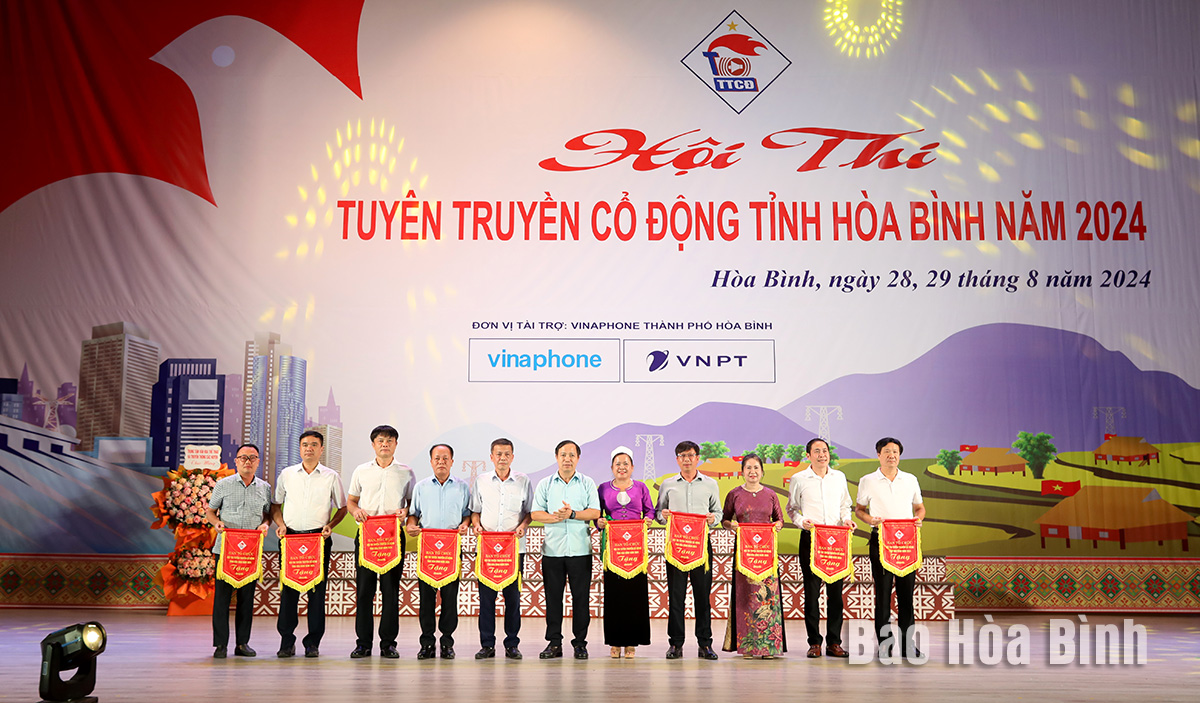
The provincial Department of Culture, Sports and Tourism held the 2024 Hoa Binh communication competition on August 28-29, with the opening ceremony seeing the presence of Nguyen Van Toan, member of the provincial Party Committee’s Standing Board, permanent Vice Chairman of the provincial People’s Committee.
Nguyen Van Toan, member of the provincial Party Committee’s Standing Board, permanent Vice Chairman of the provincial People’s Committee, presents flags to 10 teams participating in the competition.
Implementing the plan to organise the competition, nine districts and Hoa Binh city organised district-level contests with the participation of 151 dissemination teams and over 3,270 members in 498 performances.
Participating in the provincial-level contest were 10 mobile communication teams with nearly 300 members who competed in oral communication, art performances, and short plays. The total time for three parts was limited at 35 minutes.
The dissemination contents focused on studying and following the ideology, morality, and lifestyle of President Ho Chi Minh; celebrating the National Day (September 2, 1945-2024), the traditional day of the culture - information sector (August 28), and the 80th founding anniversary of the Vietnam People's Army; preserving and promoting the cultural identity of Hoa Binh's ethnic groups; and on environmental protection, food safety and hygiene, prevention and control of social evils, traffic safety, prevention and control of domestic violence, and building new-style rural areas and civilised urban areas.
The contest offered an opportunity for officials, directors, performers, and disseminators to exchange and learn about expertise and skills in cultural and artistic activities and communication work on the Party's guidelines and policies, and the State's policies and laws among localities in the whole province, thus contributing to improving the quality of activities of mobile communication teams and preserving and promoting the cultural identity of local ethnic groups.
Hoa Binh province has carried out multiple programmes and initiatives to revive its cultural heritage which has gradually fallen into oblivion through the ebbs and flows of history.
The most prominent and defining feature in the prehistoric era of Hoa Binh is the Hoa Binh Culture. The Culture was first discovered in Hoa Binh. The significant prehistoric culture represents not only Vietnam but also Southeast Asia and southern China. Through excavations of cave sites in the limestone regions of Hoa Binh, French archaeologist M. Colani introduced the world to a "Stone Age in Hoa Binh province – Northern Vietnam" in 1927. On January 30, 1932, the First Congress of Far Eastern Prehistorians, held in Hanoi, officially recognised the Hoa Binh Culture.
Known as the "Land of Epic History”, Hoa Binh province, the gateway to Vietnam’s northwest, boasts a strategic location and a unique cultural tapestry woven by its ethnic minority communities.
The People's Committee of Luong Son District recently held a ceremony to receive the certificate recognizing Sau Communal House in Thanh Cao Commune as a provincial-level historical and cultural site.
Recognising the importance of cultural heritage preservation in protecting and promoting the value system of Vietnamese culture, and serving socio-economic development in the new period, Party committees and local administrations in Hoa Binh province have identified it as a key task in the cultural development strategy. The province has been making efforts in mobilising resources, creating consensus among people and engaging ethnic communities in preserving and promoting cultural identity.
Hoa Binh province has captured growing attention both domestically and internationally for its distinctive cultural heritage and rich history. Most notably, it has been renowned for its famous Hoa Binh culture, considered the cradle of ancient Vietnamese civilisation. Looking ahead to significant milestones in 2025 and the 140th anniversary of province establishment in 2026, Hoa Binh Newspaper presents a comprehensive overview of the province's development across economic, social, cultural, tourism, and security domains.



